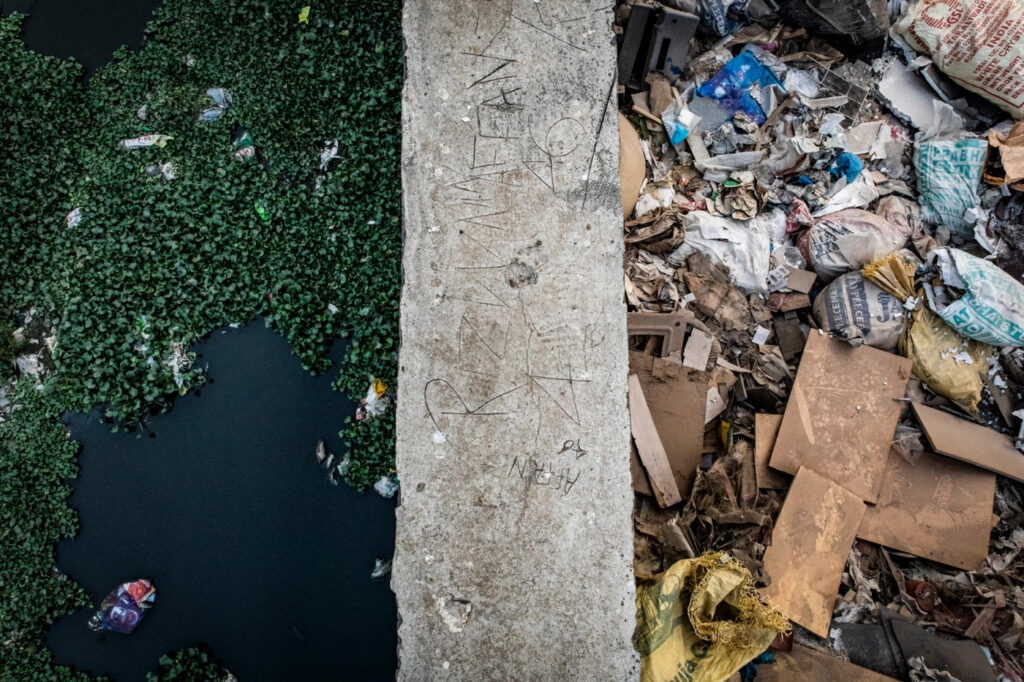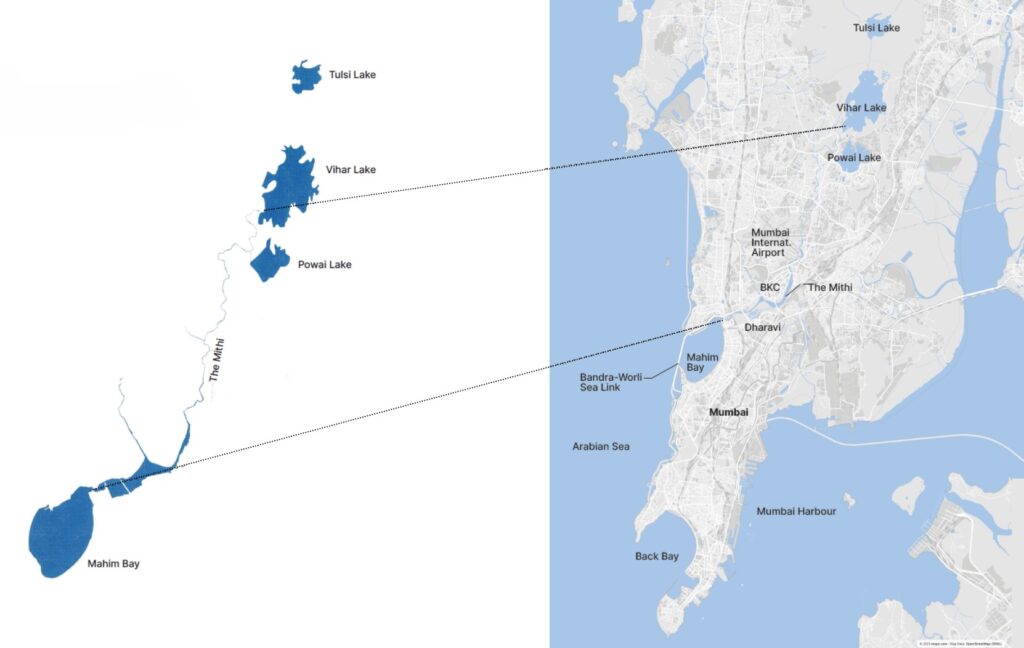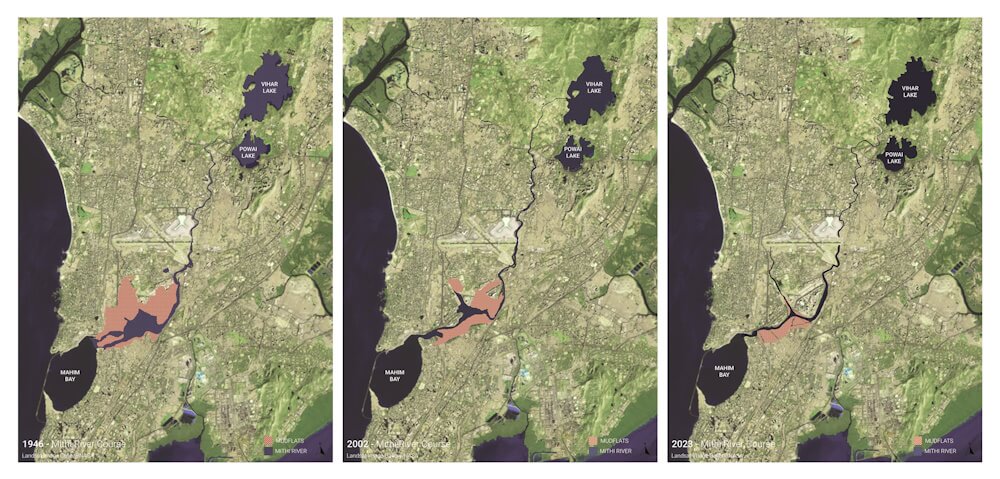
‘What does the Mithi want?’ It is a peculiar question—not only for the fact that an 18 km long river in the heart of Mumbai is being asked what it wishes but also because of the presumption that anyone would care to know. Most would respond by asking: What is the Mithi? Why should it want anything? And how does it matter what it wants?

This dissertation hopes to settle these queries through a re-reading of the Mithi’s historiography—revisiting crucial moments in its timeline to understand its seemingly natural tendencies, its position within the urban fabric of the city, and its perception within the collective memory of the people of Mumbai.
In ‘Reading the River’ (Chapter 1), the research is backdropped against the catastrophic flooding of Mumbai in July 2005. Still remembered as one of the most trying times for the city, the deluge was blamed mostly on the functional failure of the Mithi to do its job as a drain (or overflow valve) for the excesses of rain in the region. This event threw into sharp relief the dual role of the Mithi—as a drain and a river—one that was assigned to mitigate flood and the other that has a propensity to flood. Construing the repeated transformation between the river’s two distinct functions begins to spell out its persistently shifting terrain and a vulnerable ecological system that has been produced by the coercive conceptualization of earth and water, channel and river, rain and drainage, wetness and dryness.

In referencing Dilip Da Cunha’s ideas about ‘decolonising the language of landscape and history’ (2009, 2018), the study posits an imperial narrative of cartographic and planning strategies at its centre, which further draws on Arjun Appadurai’s notions about the ‘production of locality’ (1996) and the primacy of histories in creating geographies (2013). These concepts are expanded further in ‘Shape of the Water’ (Chapter 2) to show that the 2005 Mumbai floods, and the general pattern of a war between nature and human design, have created a recurrent planning disaster, for which a predominant scapegoat is the Mithi.
Reflecting on its origins and locating critical moments in its historiography, the study articulates the social, economic, political, cultural, and ecological contexts that have been and continue to play a vital role in determining the status of the Mithi in the city.
Speaking to Charles Taylor’s perspective of recognition, the lack of, or even misrecognition of objects (1992), when applied to the Mithi, posit it within changing milieus and fluctuating networks of associations. The play of expectations, accomplishments, and deliverance—on the part of humans and objects designed for and by humans, illuminates the failed attempts at redeeming the Mithi on one hand and the innumerable attempts at reforming it. While most solutions, premised on tactical calculations have buckled over time, there emerges both a space and a need for alternative thinking.



In examining the potential for designing the future of the Mithi, and in the same breath, in designing the potential for alternate futures of the Mithi, the analysis leads to asking: if indeed the river has to be blamed for Mumbai’s floods, underscoring its deficiency in serving to the people what they wanted from it, can it also not be asked: ‘What does the Mithi want?’ (Chapter 3).
This latter angle comes from WJT Mitchell’s exemplary work on pictures which sees pictures as having their own wishes—which are different from being simple mirrors of the human gaze, ideology, or sentiment of their viewers (1994, 2005). Instead, these pictures impose their force on the spectator, independent of what they might see or perceive in their capacity. In this light, if the Mithi is a human artefact, rather than a brute natural fact, then its own agency, desires and drives need to be closely examined. Pivoted on Appadurai’s ‘ethics of hope’ to imagine, anticipate, and aspire for a good life, the Mithi is framed within various prevalent conditions to hypothesise possible futures. In asking the Mithi what it wants against the scaffold of yielding power or desire, forging symbiotic or symbolic relationships, embodying visualisation or narrativization, or succumbing to abomination or adoration, the river contains multifarious scenarios. These are far from solutions—the question, posited within these various contexts becomes a trigger for further interrogation, deeper comprehension, and multiple explorations of the future of the Mithi.
In further asking ‘How can the future be reimagined?’ (Chapter 4) the framework of inquiry proliferates to generate a wider and more intricate network of provocations that the study hopes can eventually lead to solutions. It aims to join the rich body of work in the humanistic social sciences which sees non-human objects as having their forms of energy, motive, and desire (Appadurai 1986; Barad 2007; Bennett 2010; Latour 2005).
In redirecting thought from conventional answers that seek to address familiar questions, the dissertation looks at an urban environmental crisis through an unconventional methodological lens and advocates the asking of alternative questions to seek relevant answers. Therefore, in Mumbai, we begin by framing: What does the Mithi want?
ABSTRACT
The Mithi, nestled in the heart of Mumbai, India, has long remained an overlooked and severely polluted waterway, emblematic of urban rivers worldwide. In July 2005, it was unceremoniously cast into the spotlight when the catastrophic flooding of Mumbai was blamed on the functional failure of the Mithi to perform as a conduit for the overflow of excessive rain in the region. Subsequently, another deluge—of reports and initiatives—attempted to rectify the situation, yet none sustained long-term success, leaving the Mithi to deteriorate once more into a rancid sewer masquerading as a river.
This dissertation posits that after nearly two decades of research, advocacy, and labour, the persistent stagnation in the Mithi’s narrative stems not solely from implementation shortcomings but from the formulation of the core problem itself. If the questions asked are not germane to the problem, the responses derived will not be much different. Therefore, by reframing the questions, this research aims to unlock new perspectives and, consequently, novel solutions. The study endeavours to shift the paradigm of comprehending the flood, the river, and the city away from the conventional human-centric lens and towards a more holistic perspective—one that centres the Mithi itself, granting it agency and a voice in the discourse.
By redirecting the gaze from typical answers addressing opaque questions, this dissertation employs an unconventional methodological approach to analyze an urban environmental crisis. It encourages the exploration of alternative questions that lead to pertinent resolutions. Through visualizing diverse scenarios, it constructs a framework of inquiries capable of stimulating imagination, anticipation, and the aspiration for alternative futures. In the context of Mumbai, this transformative journey commences with a fundamental question: What does the Mithi want?
Read the dissertation report below



